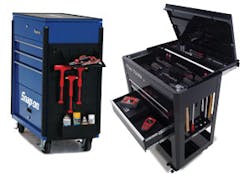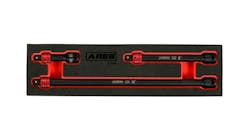The most important consideration when you’re looking to buy a tool cart is how you will use it, according to toolbox manufacturers. While that seems like a “duh” moment, it should give you pause when you’re looking at drawer configurations, colors and graphics packages to consider exactly what you need the cart to do. Whether you are using it to move tools from your toolbox to the vehicle or as a full extension of space from your toolbox will have different implications.
“If you are using it to transport parts and fluids to a job, then you basic cart should work fine,” said Tom Jech, Mac Tools strategic business manager for toolboxes and utility carts. “If you are going to be using it as an extension of your toolbox, then you should consider a cart with drawers and a lid that locks. You might want to consider a cart with a work surface on top if you will be working on components off the vehicle.”
Once you know why you want a tool cart, there are several items to consider, according to Jay Serpe, Snap-on Tools product manager for tool storage.
“If you are moving from job to job several times per day or rolling several hundred feet per day, a minimum caster size of 5” by 2” provides protection from obstacles and grates,” Serpe said. He added that caster material choice was important (quiet and durable materials are nice), as are type of lock, comfortable drawer pulls and more.
“Consider the construction,” Serpe said. “An L-bracket design usually supports more weight than square stock.”
Jech suggested looking for a cart with enough storage space to accommodate all the tools you use on an everyday basis.
“A deep top compartment is important; it allows you to store your sockets in a place where they are easily accessible,” Jech said. “A deep drawer will give you a place to store your power tools … again keeping the tools you use most close at hand.”
Features and price points
Basic carts can range from $100 to $200 and are good for moving supplies around the shop,” Jech said. “In most cases, these carts will have either no drawers or only one drawer and a shallow (3” deep) top tray.”
As with everything, the more you’re willing to pay, the quality improves and features increase.
“You will find welded case designs in the higher price points, more wide drawers, more toolbox-like construction, and locking drawers that can be opened or locked when the lid is down,” Serpe said.
“A top-of-the-line cart can cost $1,000 to $2,000, and really is an extension of the technician’s toolbox,” Jech said. Features will include a reinforced or stainless-steel work surface and caster supports for added mobility and storage capacity, he said.
“Like toolboxes, more add-ons are being introduced for carts,” Jech said. “Items such as side shelves, small side boxes, and screwdriver and pry bar holders are all available now for utility carts.
“You are also seeing utility carts coming into the market that are specific to jobs — carts designed to store and transport diagnostic equipment have become more popular.
“Today you are seeing carts that are designed and tested to the same performance specifications as toolboxes,” Jech said.
“Carts are available in everything, from a simple two-tray unit to super-wide units with six or more drawers and a flip lid,” Serpe said. “We at Snap-on would like to see pictures of some of the ways carts have been customized to fit personal needs.”
For more information:
www.mactools.com
www.snapon.com


